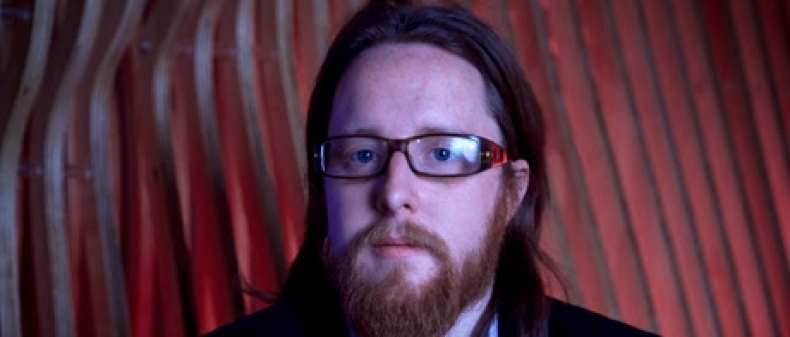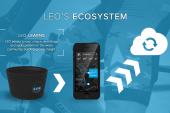
Movers and Starters is an exclusive series that profiles the individuals who drive Toronto’s startup community.
Tell us who you are.
My name’s Trevor Coleman, and I’m one of the founders of InteraXon. We’re a company that does brain sensing technology. My role here is as Chief Product Officer, so I’m responsible for making sure that the products we’re building mean something to people, and that they make the best possible use of technology.
For those that don’t know, can you explain what InteraXon does?
We’re developing a product called Muse. Muse is a brain sensing headband that uses a technique called EEG (Electroencephalography) to measure the electrical activity that’s generated by a person’s brain. Using our technology, we can measure different brainwaves generated by a person’s brain, which can tell us things like how relaxed or focused a person is. We’re also working on other algorithms that can detect when a person’s mind becomes distracted by something and how distracted it’s making them. We’re looking at building tools that can help people train their attention, which will hopefully help increase their mood and productivity.
Both you and your co-founders have interesting backgrounds, but I’d particularly like to know how Toronto’s self-described former King of the Hipsters went from throwing parties at the Boat to helping build a brain sensing headband?
(Laughs) Well, I’ve always been interested in the brain. Before I was throwing parties at the Boat, I studied Cognitive Science at York University, and even before university I was always fascinated by the brain.
In the early to mid 2000s, I started throwing parties. I started off with parties at my house for ten to twenty people, and then I moved to throwing parties at much larger houses and loft spaces. The biggest house party I ever put together included five bands, three DJs, and two sound systems on two floors. It was a really good party. From there, I went to booking shows at the Boat.
The common thread between throwing parties and what I do is that they’re both experience design. At a party, you’re designing a kind of disposable experience; a party isn’t about the stuff that’s there so much as it is about the attitude people have while they’re at that party. It’s about creating a change in a person’s perception of the people around them, and creating a space where it’s okay to talk to new people.
I used to create experiences with sound system and DJs. Now I use touch screens and brain sensing technology.
When you’re in your early 20s, it’s hard to say no to throwing parties for a living. I think if you’re not going to a lot of parties in your early 20s, then you’re probably missing out on something, and if you’re still partying in your 30s, then you’re also missing out on something. It felt like a natural time come back and start working on this stuff; I’ve always wanted to do something kind of neat.
It’s also not that I saw myself at this particular company at this particular time in my life, but having gotten involved with [co-founders] Ariel [Garten] and Chris [Aimone], and having started to build this business over the last five or six years, it’s not like this was a sudden change; there was certainly a long transition period. That said, this is definitely the most exciting thing I’ve ever been involved in and it definitely feels like an upgrade.
When did you get involved with InteraXon?
Around 2007, I was promoting at Circa. Ariel came to me–she was dating one of my really good friends at the time–and said, “I got this great technology that people should really know about. You’re a part of this club, so why don’t we see what we can make happen here.”
We started looking at different ways we could make an interactive installation inside of Circa, but technology being what it is, that sort of stuff costs a lot of money. So we looked at places where we could get funding, and that’s when I came up with the idea of approaching marketing agencies to see what kind of projects we could partner on, and that’s also about the time where I started to think of what we were doing less as a creative project and more as a business.
Over the next couple of years, we pitched different agencies, worked in a basement on our business plan, talked to advisors, and eventually got involved with MaRS. In 2009, we got hooked up with the Ministry of Research and Innovation to help them with the Premier’s Innovation Awards. From there, we spring boarded up to the Vancouver Olympics, and since then the business has grown pretty organically.
It’s always been our goal to have a hardware product; there’s something nice about making a thing that people can own. There’s also something to be said about not relying on other people’s hardware–in some cases, the hardware we were looking at was either too expensive, or if it was cheaper, the signal fidelity we needed wasn’t there.
No one product on the market did exactly everything we needed it to do–it had to be easy to put on a person’s head, it had to get a good signal, and it had to be able to run the applications we designed for it. So it was about a year-and-a-half ago that we saw this gap in the market where there was a place for a comfortable, stylish, and easy to use brain sensing headband, and that’s when we started really aggressively pursuing our product strategy.
Dr Mann and Dr Fung are two people that are often mentioned in the InteraXon story. Want to tell us about them and their contribution to the company?
Steve Mann is someone who Chris and Ariel worked with at his private laboratory–He’s a professor at the University of Toronto, but he also has a private lab. He started working with EEG and brain sensing technology at MIT in the 90s. One of the projects he worked on with Ariel and Chris was a concert where around 40 people controlled different parts of a performance with their mind. The 40 people taking part in the concert would split up into groups, and each group would control a different aspect of the performance. So whether it was putting a filter on one of the instruments or changing the ambient lighting in the room, the people taking part in the performance would create this sort of organic environment that was a product of what they were thinking and feeling, but the performance also had the effect changing how the people creating it were feeling. So it created this really neat feedback loop.
That work with Steve and James [Fung] was part of what inspired us to pursue what we’re doing now. We’re really grateful to have had the chance to work with them. They’re also our friends, and we love working with them.
When people think of brain sensing technology, they immediately think of the control applications, but a lot of the marketing I’ve read for the Muse focuses on the, for the lack of a better word, spiritual benefits of using the technology. Where does that come from?
We’ve always viewed this technology as something that can help people achieve a new level of possibility. Certainly, there are control applications, but the fact of the matter is that our hands are very good at controlling things. It’s going to be a while before any technology gives you the same kind of fluidity you have with your hands. For us, control is something that will come eventually, but in the meantime, there is this amazing power this technology already has, which is to show you something about yourself that you didn’t know was there. It makes a part of you that was invisible visible.
So that’s why so much about this technology is about self-discovery and self-knowledge. When you look at the benefits of knowing yourself better, they’re mostly things that are intangible, but we think that there are a lot of tangible benefits as well. You look at benefits like improved memory, improved mood, or reduced stress–those kinds of things will make a person’s life better.
As human beings, we’re subject to a lot of distractions. They can be external distractions, or they can be internal ones–so things like strong emotions and physical pain. We’re trying to build a system that will help people not fall prey to those distractions. Muse will give a person feedback when they’re getting distracted, so that they can bring their attention back to the task they were working on. I think something like that is going to unlock a lot of potential in people.
What was it like the first time you personally used the technology?
I went over to James Fung’s house. He had this computer with a black box and a fibre optic cable that went to an elastic band that you put around your head. This headband allowed you to control a fader on a computer screen. As you would relax, the fader would go down, and, as you focused, the fader would go up. I remember having this bizarre experience where I was just having thoughts–I wasn’t doing anything–and then something on the screen was happening as a result of what I was thinking.
A lot of how we define who we are as a person is by what we can directly control: I know my hand is a part of me because I can control it with a single thought. Whereas this chair here is not a part of me; I can look at it all day and it won’t do anything. But what happens when you control something outside of yourself? Suddenly, your sense of self expands, and your boundary as a person changes. That’s a really neat moment. We’ve had around 17,000 people try our technology, and every time it works, they’re just like, “What is this thing?” People don’t have the words to describe the experience; it’s something as a society we’re still figuring out the right words to use to describe.
What have been some the challenges of trying to convey and explain this technology to people?
I think the challenge is that we have a familiarity with words like chiriplets and wavelets. To me, they’re just normal words, but when you’re encountering someone who’s new to the technology, there’s so many terms and ideas they have to learn before they’re able to understand what we’re doing.
That said, it’s about figuring out the least number of words that most accurately describe the process. It’s very easy to write the magical story of what Muse is doing, but to describe that process in a way that’s clear, accurate, and without overloading the user with unnecessary terms is much more challenging. So the challenge is to find what the minimum necessary amount of words is to explain the technology to someone. That’s the real challenge, and we’re constantly trying to do that ourselves.
So much of the character of this company seems to come from the interesting and varied backgrounds of you and your co-founders. Can you tell us more about Ariel and Chris?
Ariel‘s family’s background is in real-estate. She sold her first house when she was 17. She also has a deep design background, and a degree in Neuroscience. One year she opened Toronto Fashion Week. So she’s the design, brains, and business smarts of the company.
Chris has a MASc. from UofT. He’s also an award winning designer–he designed a yo yo powered MP3 player when he was in school–and is also a competitive gymnast.
We all come from interdisciplinary backgrounds, and I think that helps us with developing this technology; it’s a technology that takes such an interdisciplinary approach to make it useable. It’s not just about the algorithms; yeah, algorithms are important, but all they give you is a number to output. You have to make that number mean something to someone. At the same time, you also need a hardware device that’s comfortable for people to use, and one that doesn’t make them feel like an idiot when they wear it. There’s a lot that goes into this whole thing.
Certainly there’s a lot about this company that’s a weird confluence of our personalities–you can see the gymnastics mat in the corner there. We’re a strange bird as far as companies go, and I don’t think there are a lot of companies out there that are exactly like us. But I think that one of our greater strengths is that we’ve created an environment people want to work in, and the InteraXon is definitely more engaging than the average workplace. We tell our employes that they can come and go as they please, and we regularly find them at their desk at 10pm working away. We know because we’re here, too. It’s great to be with a team with of people that is that engaged with what we’re doing. I think our passion as co-founders is the key to that.
What do you say to those that have privacy concerns with this technology?
Well, I don’t think it’s unreasonable for people to be worried about privacy when it comes to this technology, especially when you look at how companies like Facebook have handled people’s privacy. At InteraXon, we think that it is really important for us to maintain people’s privacy, and to help them understand how the device works.
That said, it’s important to note that this technology is entirely safe. It works like a radio antenna, so it only receives signals. We’re also working on forming the International Centre for Brainwave Effects. We’re looking to work with leaders in academia, ethics, and business to develop a code of conduct that will guide the use of brainwave technology.
We believe that you should own your own brainwave data, and that no one else should be able to share it without your explicit consent. If you do decide to share it, then you should also know with whom it’s being shared with and when it’s being shared. We take these issues very seriously, as we want to make this into a platform that people can trust. These are not your profile pictures, its your bio sensor data, and there are a lot of reasons we need to be careful about protecting it.
As a company, we want to create something that enhances and enables human beings; we don’t like the idea of using this technology for negative stuff.
Where do you hope to see this technology go in the next five to ten years?
I mean I hope this technology will be everywhere. I think that everyone will have a brain sensor in ten years. You might have heard of the sensor revolution. Right now, you’re carrying around a device that has 11 sensors inside of it. Your smart phone can detect sound, acceleration, gyroscopic orientation, light, and it can also detect when your face is close to it with its proximity sensor. In fact, newer phones even have barometric sensors built into them.
The next the level is sensors that are going to be on us. It’s broken now, but I had a sensor from Nike that measured my everyday physical activity. If you have one of those sensors and you have to go to your doctor, you at least have some useful information to share with them. Imagine everyone in a meeting wearing a brainwave headband. If they’re in a meeting for 45 minutes and their attention starts to fall off, then the headband could tell them to take a 15 minute break.
Anything to add?
This is the definitely the most fun group of people I’ve had the chance to work with. It’s great to wake up every day and come work here.
WATCH: Standard Profile: Interaxon
____
Igor Bonifacic is a writer working for the Toronto Standard. You can follow him on twitter @igorbonifacic.
For more, follow us on Twitter @TorontoStandard and subscribe to our newsletter.














